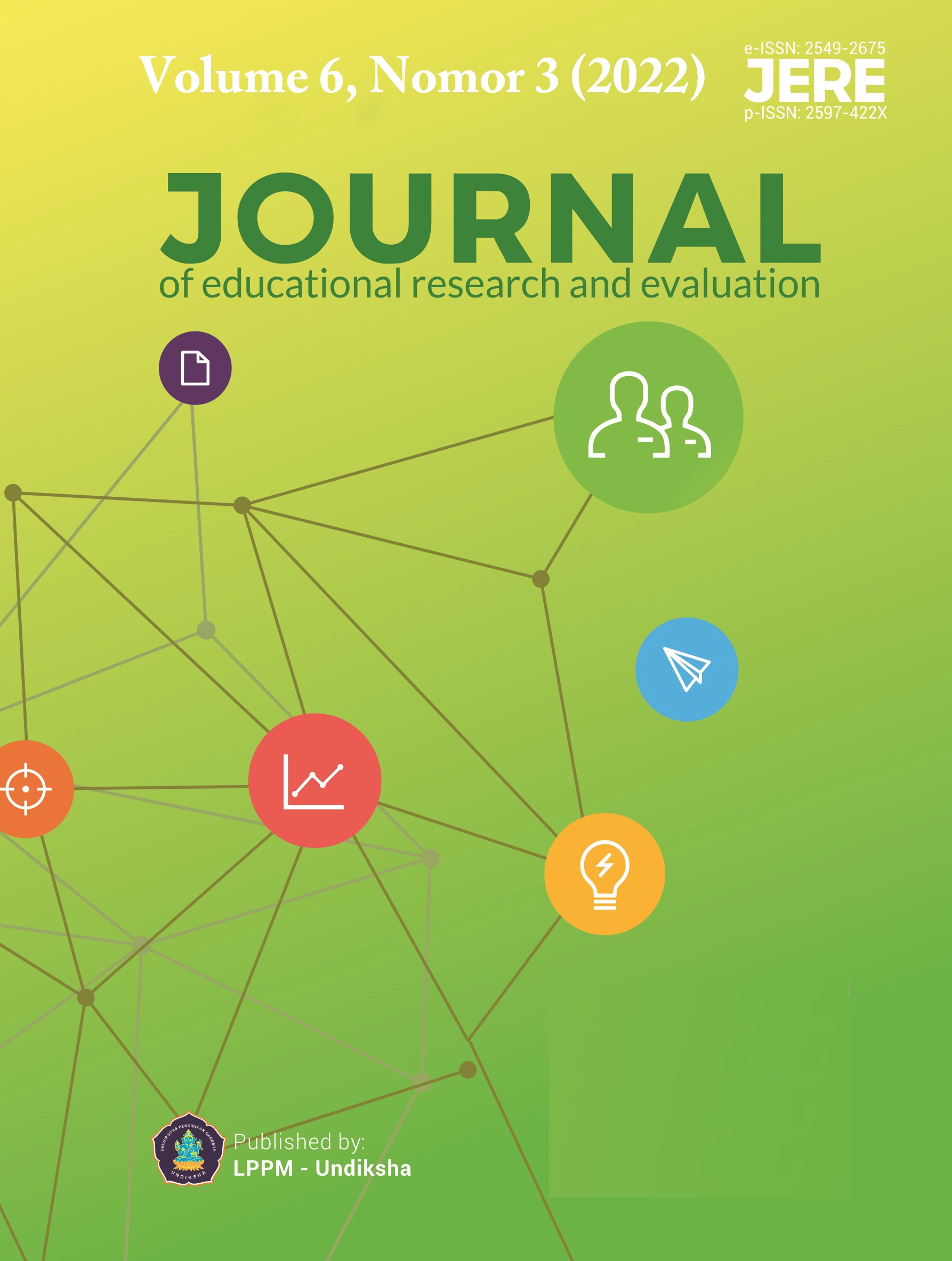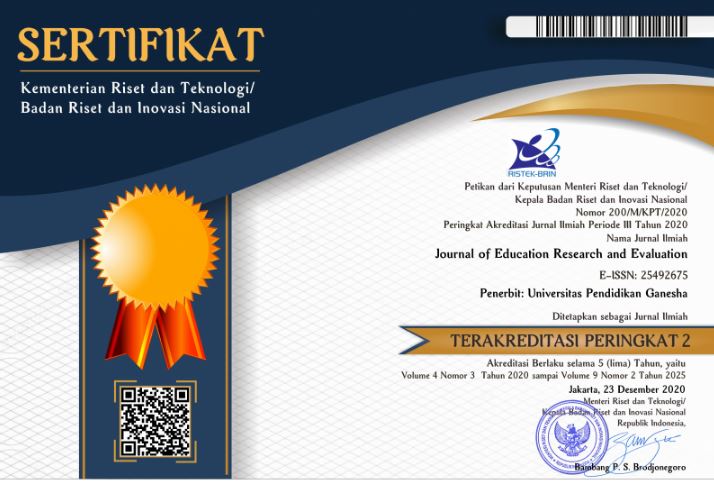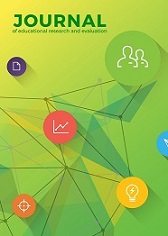How Picture Storybook Improve Creative Thinking Skills and Learning Outcomes of Elementary School Students?
DOI:
https://doi.org/10.23887/jere.v6i3.45566Keywords:
Picture storybook, creative thinking skills, student learning outcomesAbstract
The lack of creative and innovative media use can make the atmosphere of learning activities tend to be boring and students find it difficult to understand the subject matter discussed in class, so that students become less active, independence and interaction of students in the learning process is not visible so that students tend to be passive and uncommunicative. This study aims to produce an appropriate Picture Storybook, produce the practical picture Storybook, and reveal the effectiveness of the media produced to improve students’ thinking skills and learning outcomes. This research was R&D with the Borg & Gall model. The subjects in this study were fourth-grade elementary school students. Data collection in the initial study was carried out through observation and interviews. Product validation was carried out by material experts and media experts. Data analysis used independent sample t-test and MANOVA test. The results of this study are in the form of a picture storybook that is suitable for use based on the results of the validation with the "very appropriate" category. Independent sample t-test on creative thinking skills resulted in a significance value of 0.008, which means that there is a difference in the average creative thinking skills of students who use picture storybook media. Independent sample t-test on student learning outcomes resulted in a significance value of 0.001, which means that there is a difference in the average student learning outcomes using picture storybook media. The MANOVA test results show a significance value of 0.001 less than 0.05, which means that the picture Storybook media has a significant effect on creative thinking skills and learning outcomes.
References
Abdo, M., & Semela, T. (2010). Teachers of poor communities: The tale of instructional media use in primary schools of Gedeo Zone, Southern Ethiopiaj. Australian Journal of Teacher Education, 35(7), 78–92. https://doi.org/10.3316/INFORMIT.818668041340479.
Antara, I. G. W. S., & Dewantara, K. A. K. (2022). E-Scrapbook: The Needs of HOTS Oriented Digital Learning Media in Elementary Schools. Journal for Lesson and Learning Studies, 5(1), 71–76. https://doi.org/10.23887/jlls.v5i1.48533.
Antara, I. G. W. S., Suma, K., & Parmiti, D. P. (2022). E-Scrapbook: Konstruksi Media Pembelajaran Digital Bermuatan Soal-soal Higher Order Thinking Skills. Jurnal Edutech Undiksha, 10(1), 11–20. https://doi.org/10.23887/jeu.v10i1.47559.
Ardhiniswari, R. S., Subroto, W. T., & Jacky, M. (2020). Pengembangan Media Digital Picture Book Berbasis. Jurnal Education and Development, 8(3), 363–371. http://journal.ipts.ac.id/index.php/ED/article/view/2001.
Arfinanti, N. (2018). Pengembangan Media Pembelajaran Matakuliah Metode Numerik dengan Implementasi Scilab Berbantuan Software Latex. Al-Khwarizmi: Jurnal Pendidikan Matematika Dan Ilmu Pengetahuan Alam, 6(2), 121–138. https://doi.org/10.24256/jpmipa.v6i2.370.
Arsyad, A. (2014). Media Pembelajaran. PT Raya Grafindo Persada.
Arum, T. S., & Wahyudi, W. (2016). Pengembangan Modul Pembelajaran Tematik Integratif Subtema Hubungan Makhluk Hidup Dalam Ekosistem Pendekatan Saintifik Untuk Kelas 5 Sd. Scholaria : Jurnal Pendidikan Dan Kebudayaan, 6(3), 239. https://doi.org/10.24246/j.scholaria.2016.v6.i3.p239-250.
Barbot, B., Cerda, K., & Teo, T. (2020). Negative ideation in creative problem-solving is task-specific too: Evidences from a sample of incarcerated juveniles. Thinking Skills and Creativity, 38. https://doi.org/10.1016/j.tsc.2020.100740.
Beeck, N. (2015). On comics-style picture books and picture-bookish comics. Children’s Literature Association Quarterly, 37(4), 468–476. https://muse.jhu.edu/article/491143/summary.
Beghetto, R. A. (2008). Prospective teachers’ beliefs about imaginative thinking in K-12 schooling. Thinking Skills and Creativity, 3(2), 134–142. https://doi.org/10.1016/j.tsc.2008.06.001.
Budiani, S., Sudarmin, & Syamwil, R. (2017). Evaluasi Implementasi Kurikulum 2013 di Sekolah Pelaksana Mandiri. Innovative Journal of Curriculum and Educational Technology, 6(1), 45–57. https://journal.unnes.ac.id/sju/index.php/ujet/article/view/15998.
Colwell, C. (2013). Children ’ s storybooks in the elementary music classroom : a description of their use by orff-schulwerk teachers children ’ s storybooks in the elementary by orff-schulwerk teachers. Approaches: Music Therapy & Special Music Education, 5(2). https://kuscholarworks.ku.edu/handle/1808/14153.
Daryanto. (2010). Media Pembelajaran. Satu Nusa.
Ersoy, E., & Başer, N. (2014). The Effects of Problem-based Learning Method in Higher Education on Creative Thinking. Procedia - Social and Behavioral Sciences, 116, 3494–3498. https://doi.org/10.1016/j.sbspro.2014.01.790.
Eryilmaz, S., Adalar, H., & Icinak, A. (2015). E-learning as a teaching strategy actively used in fatih project. European Journal of Educational Research, 4(1), 38–47. https://doi.org/10.12973/eu-jer.4.1.38.
Eshun, E., & Amoako-Agyeman, K. (2016). Measuring creativity with divergent thinking tasks: Communication design students’ experience. International Journal of Innovation, Creativity and Change, 2(4), 122–155. https://www.ijicc.net/images/Vol2iss4/Measuring_creativity.pdf.
Fitri, Saparahayuningsih, & Agustriana. (2017). Perencanaan Pembelajaran Kurikulum 2013 Pendidikan Anak Usia Dini. Jurnal Ilmiah Potensia, 2(1). https://doi.org/https://doi.org/10.33369/jip.2.1.1-13.
Ghazi, S. R., Ullah, K., & Jan, F. A. (2016). Concrete operational stage of Piaget’s cognitive development theory: An implication in learning mathematics. Gomal University Journal of Research, 32(1), 9–20. http://www.gujr.com.pk/index.php/gujr/article/view/133.
Hadar, L. L., & Tirosh, M. (2019). Creative thinking in mathematics curriculum: An analytic framework. Thinking Skills and Creativity. https://doi.org/https://doi.org/10.1016/j.tsc.2019.100585.
Halford, G. S. (2016). Cognitive developmental theories. In The Curated Reference Collection in Neuroscience and Biobehavioral Psychology (pp. 298–308). Elsevier Science Ltd. https://doi.org/10.1016/B978-0-12-809324-5.05787-4.
Heo, J. (2012). The effect od using three types of instructional media on comprehension and motivation of korean college students in an online course. University of Nevada, Reno.
Hosnan, M. (2014). Pendekatan Saintifik dan Konstektual dalam Pembelajaran Abad 21: Kunci Sukses Implementasi Kurikulum 2013. Ghalia Indonesia.
Kustandi, C., & Sutipto, B. (2013). Media Pembelajaran: Manual dan Digital. Ghalia Indonesia.
Mahfud, I., & Fahrizqi, E. B. (2020). Pengembangan Model Latihan Keterampilan Motorik Melalui Olahraga Tradisional Untuk Siswa Sekolah Dasar. Sport Science and Education Journal Universitas, 1(1), 31–37. https://doi.org/10.33365/.v1i1.622.
Massey, S. R. (2015). The multidimensionality of children’s picture books forupper gradses. English Journal, 104(5), 45–48. https://www.proquest.com/openview/cb3b1b2723fd8c56d4a0e29f06a5d854/1?pq-origsite=gscholar&cbl=42045.
Mawanto, A., Yuli, T., Siswono, E., Lukito, A., Surabaya, U. N., Wetan, J. L., & Surabaya, K. (2020). Pengembangan Media Cerita Bergambar untuk Melatih Kemampuan Berpikir Kreatif Siswa pada Materi Pecahan Kelas II. Jurnal Cendekia: Jurnal Pendidikan Matematika, 4(1), 424–437. https://doi.org/10.31004/cendekia.v4i1.243.
McGregor, D. (2007). A Guide to Thinking Skills in Education Developing Thinking ; Developing Learning (1st ed.). Open University Press.
Milicevic, A., Woolfe, S., Blazely, A., Lenroot, R., & Sewell, S. (2020). Enhancing creativity through seven stages of transformation in a graduate level writing course—A mixed method study. Thinking Skills and Creativity, 38. https://doi.org/10.1016/j.tsc.2020.100712.
Mol, S. E., Bus, A. G., & de Jong, M. T. (2009). Interactive book reading in early education: A tool to stimulate print knowledge as well as oral language. SAGE Journals: Review of Educational Research, 79(2), 979–1007. https://doi.org/10.3102/0034654309332561.
Mullet, D. R., Willerson, A., N., Lamb, K., & Kettler, T. (2016). Examining teacher perceptions of creativity: A systematic review of the literature. Thinking Skills and Creativity, 21, 9–30. https://doi.org/10.1016/j.tsc.2016.05.001.
Ozsezer, M. S. B., & Canbazoglu, H. B. (2018). International Journal of Educational Methodology Picture in Children ’ s Story Books : Children ’ s Perspective. 4(4), 205–217. https://doi.org/10.12973/ijem.4.4.103.
Pariser, D., Kindler, A., van den Berg, A., Dias, B., Liu, W. C., & Diaz, B. (2007). Does practice make perfect? Children’s and adults’ constructions of graphic merit and development: A crosscultural study. Visual Arts Research, 33(2), 96–114. https://www.jstor.org/stable/20715452.
Parmiti, D., Rediani, N., Antara, I., & Jayadiningrat, M. (2021). The Effectiveness of Local Culture-Integrated Science Learning Through Project Based Assessment on Scientific Attitudes and Science Process Skills of Elementary School Students. Jurnal Pendidikan IPA Indonesia, 10(3), 439–446. https://doi.org/10.15294/jpii.v10i3.31301.
Partiningsih, S. (2018). Hubungan Kemampuan Berpikir Kreatif dan Penguasaan Konjungsi dengan Kemampuan Menulis Narasi. Jurnal ISIP: Jurnal Ilmu Sosial Dan Ilmu Politik, 15(1), 57. https://doi.org/10.36451/j.isip.v15i1.14.
Piaw, C. Y. (2014). Effects of gender and thinking style on student’s creative thinking ability. Procedia-Social and Behavioral Sciences, 116, 5135–5139. https://doi.org/10.1016/j.sbspro.2014.01.1087.
Prieto, M. D., Ferrándiz, C., Ferrando, M., Sáinz, M., Bermejo, R., & Hernández, D. (2008). Emotional intelligence in high-ability students: A comparative study between Spain and England. Electronic Journal of Research in Educational Psychology, 6(2), 297–320. http://investigacion-psicopedagogica.org/revista/articulos/15/english/Art_15_254.pdf.
Redhana, I. W. (2019). Mengembangkan Keterampilan Abad Ke-21 Dalam Pembelajaran Kimia. Jurnal Inovasi Pendidikan Kimia, 13(1).
Saccardi, M. (2014). Creativity and Childern’ Literature New Way to Encourage Divergent Thinking. Libraries Unlimited.
Sari, A. P., Ikhsan, M., & Saminan, S. (2017). Proses berpikir kreatif siswa dalam memecahkan masalah matematika berdasarkan model Wallas. Beta: Jurnal Tadris Matematika, 10(1), 18–32. https://doi.org/10.20414/BETAJTM.V10I1.102.
Schwartz, S. (2012). Abnormal Psychology: a discovery approach. Mayfield Publishing Company.
Siswono, H. (2017). Analisis Pengaruh Keterampilan Proses Sains Terhadap Penguasaan Konsep Fisika Siswa. Momentum: Physics Education Journal, 1(2), 83–90. https://doi.org/10.21067/mpej.v1i2.1967.
So, K., & Hu, Y. (2019). Understanding creativity in an Asian school context: Korean teachers’ perspectives. Thinking Skills and Creativity, 33, 100573. https://doi.org/10.1016/j.tsc.2019.100573.
Souisa, T. R., Lekatompessy, J., & Ferdinandus, M. (2020). Diglot Picture Storybook Based on Maluku Content and Its Relevance for Young Learners’ Literacy. Jurnal Tahuri, 17(2), 84–95. https://doi.org/10.30598/tahurivol17issue2page84-95.
Voroshilov, V., Mihardi, S., Harahap, M. B., & Sani, R. A. (2018). Creativity in schools’ education. Journal of Education and Practice, 6(1), 1–16. https://doi.org/10.16986/HUJE.2015014138.
Yokota, J., & Teale, W. H. (2014). Picture books and the digital world: Educators making informed choices. The Reading Teacher-International Literacy Association (ILA), 67(8), 577–585. https://doi.org/10.1002/trtr.1262.
Zohrabi, M., Dobakhti, L., & Pour, E. M. (2019). Interpersonal meanings in children’s storybooks. Iranian Journal of Language Teaching Research, 7(2), 39–64. https://eric.ed.gov/?id=EJ1220757.
Downloads
Published
How to Cite
Issue
Section
License
Copyright (c) 2022 Lutfi Andi Darmawan, Wuri Wuryandani

This work is licensed under a Creative Commons Attribution-ShareAlike 4.0 International License.
Authors who publish with the Journal of Evaluation and Research in Education (JERE) agree to the following terms:
- Authors retain copyright and grant the journal the right of first publication with the work simultaneously licensed under a Creative Commons Attribution License (CC BY-SA 4.0) that allows others to share the work with an acknowledgment of the work's authorship and initial publication in this journal.
- Authors are able to enter into separate, additional contractual arrangements for the non-exclusive distribution of the journal's published version of the work (e.g., post it to an institutional repository or publish it in a book), with an acknowledgment of its initial publication in this journal.
- Authors are permitted and encouraged to post their work online (e.g., in institutional repositories or on their website) prior to and during the submission process, as it can lead to productive exchanges, as well as earlier and greater citation of published work. (See The Effect of Open Access)











